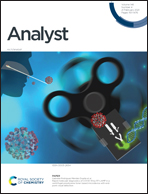Highly sensitive real-time detection of intracellular oxidative stress and application in mycotoxin toxicity evaluation based on living single-cell electrochemical sensors†
Abstract
Single-cell electrochemical sensor is widely used in the local selective detection of single living cells because of its high spatial–temporal resolution and sensitivity, as well as its ability to obtain comprehensive cellular physiological states and processes with increased accuracy. Functionalized nanoprobes can detect the oxidative stress response of cells in single-cell electrochemical sensors. Moreover, the T-2 toxin is one of the most toxic mycotoxins and widely occurs in field crops. T-2 toxin can cause mitochondrial damage in cells and increase intracellular reactive oxygen species (ROS) in various cells. As the most representative free radical of intracellular ROS, H2O2 can effectively reflect the toxic effects of intracellular T-2 toxin. In this study, a functionalized gold nanoprobe was used to dynamically monitor the production of H2O2 in a single live human hepatoma cell HepG2 stimulated by mycotoxin T-2. The concentration of H2O2 produced by HepG2 cells stimulated by T-2 toxin at 1 ppb–1 ppm was linearly correlated, R2 = 0.99055, and LOD = 0.13807 ng mL−1. Sample spiking experiments were conducted, and the recovery rate of spiking was 81.19%–130.17%. A comparative analysis of differences in the current produced by multiple toxins, HT-29 cells, as well as single cells in cell populations, was performed. This method can be applied in real-time monitoring of mycotoxin toxicity during food processing in living cells and provides a novel idea for enhancing food quality and safety in a nanoenvironment.



 Please wait while we load your content...
Please wait while we load your content...